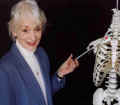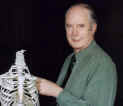 |
 |
 |
Helping You To Achieve ©™

![]()
Helping You To Achieve ©™
|
|
Identify by palpation and surface mark with a pen, the Lesser Tubercle of the Humerus on a model in the anatomical position with side lighting and a time limit of one minute.
Objective No 6 - Criteria to be demonstrated. 1. Identify the tip of the Coracoid process of the Scapula (Objective No 3) 2. Identify the Greater Tubercle of the Humerus. (Objective No 5) 3. Draw a horizontal line between the tip of the Coracoid process and the Greater Tubercle. 4. Identify the Lesser Tubercle of the Humerus lying just below the mid point of the horizontal line. 5. Palpate the Lesser Tubercle of Humerus at this point in step 4 through the Anterior fibres of Deltoid. 6. Request the model to rotate the Humerus with the palpating finger tip on the Lesser Tubercle of Humerus. 7. The Lesser Tubercle of Humerus can be identified as a rotating bony prominence through the Anterior fibres of Deltoid.
|
Service ProvisionBronze. Students may take up a ,'Free start up ' package consisting of 100 of the behavioural objectives and criteria based on common questions asked in Living Anatomy. These are available free of charge on this Website. Silver. Students may buy a copy of the book "Surface and Living Anatomy" (ISBN: 0 7234 3261 9) which comes with a CD Rom (Windows PC format) containing 230 objectives which includes the 100 behavioural objectives contained in the Bronze Service. Gold "Helping you to Achieve" Contact Information
|